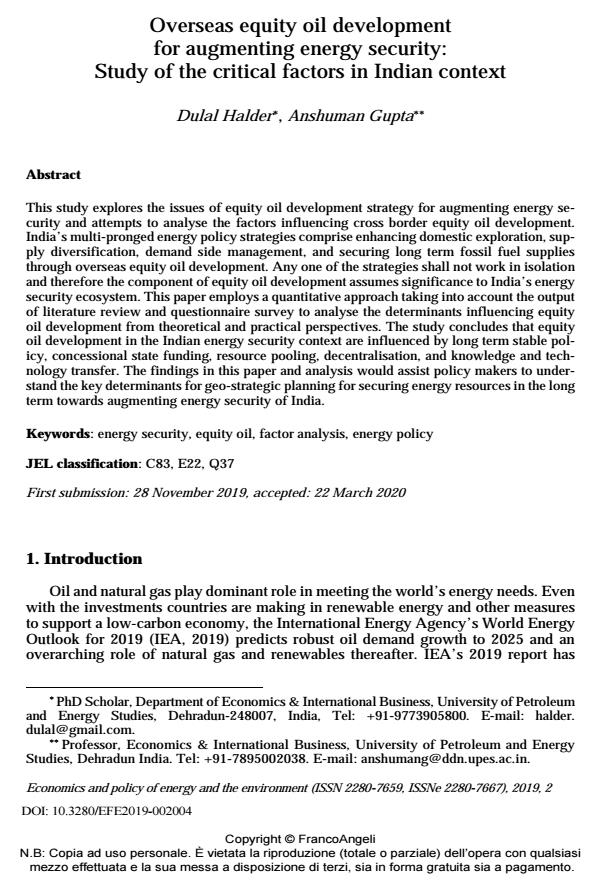Overseas equity oil development for augmenting energy security: Study of the critical factors in Indian context
Titolo Rivista ECONOMICS AND POLICY OF ENERGY AND THE ENVIRONMENT
Autori/Curatori Dulal Halder, Anshuman Gupta
Anno di pubblicazione 2020 Fascicolo 2019/2 Lingua Inglese
Numero pagine 23 P. 75-97 Dimensione file 243 KB
DOI 10.3280/EFE2019-002004
Il DOI è il codice a barre della proprietà intellettuale: per saperne di più
clicca qui
Qui sotto puoi vedere in anteprima la prima pagina di questo articolo.
Se questo articolo ti interessa, lo puoi acquistare (e scaricare in formato pdf) seguendo le facili indicazioni per acquistare il download credit. Acquista Download Credits per scaricare questo Articolo in formato PDF

FrancoAngeli è membro della Publishers International Linking Association, Inc (PILA)associazione indipendente e non profit per facilitare (attraverso i servizi tecnologici implementati da CrossRef.org) l’accesso degli studiosi ai contenuti digitali nelle pubblicazioni professionali e scientifiche
This study explores the issues of equity oil development strategy for augmenting energy security and attempts to analyse the factors influencing cross border equity oil development. India’s multi-pronged energy policy strategies comprise enhancing domestic exploration, supply diversification, demand side management, and securing long term fossil fuel supplies through overseas equity oil development. Any one of the strategies shall not work in isolation and therefore the component of equity oil development assumes significance to India’s energy security ecosystem. This paper employs a quantitative approach taking into account the output of literature review and questionnaire survey to analyse the determinants influencing equity oil development from theoretical and practical perspectives. The study concludes that equity oil development in the Indian energy security context are influenced by long term stable policy, concessional state funding, resource pooling, decentralisation, and knowledge and technology transfer. The findings in this paper and analysis would assist policy makers to understand the key determinants for geo-strategic planning for securing energy resources in the long term towards augmenting energy security of India.
Keywords:Energy security, equity oil, factor analysis, energy policy
Jel codes:C83, E22, Q37
- Alam A., Khan S., Zafar F. (2014). Strategic management: Managing Mergers and Acquisition. International Journal of BRIC Business Research, 3(1).
- Al-Emadi T. (2010). A Literature Review of JVCs Development, Concept and Elements. Oxford University Faculty of Law.
- Beccue P. C., Huntington H. G., Leiby P. N., Vincent K. R. (2018). An updated assessment of oil market disruption risks. Energy Policy, 115: 456-469.
- Bhattacharya K., Bhattacharya I. (2001). Impact of Increase in Oil Prices on Inflation and Output in India. Economic and Political Weekly, 36(51): 4735-4741.
- Brown S. P. A., Huntington H. G. (2018, May). Oil Supply Disruptions, U.S. Economic Activity and Oil Security, Energy Policy, 116: 297-298.
- Buckley P. J. et al. (2014). Foreign Acquisitions by Indian firms. Costa-Campi M. T., Jamasb T., Trujillo-Baute E. (2018). Economic analysis of recent energy challenges: Technologies, markets, and policies. Energy Policy, 118: 584-587.
- Cronbach L. J., Meehl P. E. (1955). Construct Validity in Psychological Tests. Psychological Bulletin, 52(4): 281-302.
- Fengyan F., Yalin L. (2017, October). Factor analysis of energy-related carbon emissions: A case study of Beijing. Journal of Cleaner Production, 163, Supplement: S277-S283.
- Habing B. (2003). Exploratory Factor Analysis. -- http://www.stat.sc.edu/~habing/courses/530EFA.pdf.
- Hair J. F. et al. (2009). Multivariate data analysis: A global perspective.
- Huntington H. G. (2018). Measuring oil supply disruptions: A historical perspective, Energy Policy, 115 (April): 426-433.
- Hutcheson G., Sofroniou N. (1999). The Multivariate Social Scientist: Introductory Statistics Using Generalized Linear Models. Thousand Oaks, CA: Sage Publication.
- Jie Z., Shiqin G. (2015). China’s Food Security Evaluation Based on Factor Analysis. American Journal of Industrial and Business Management, 5(6) (June).
- Kaiser H. F. (1974). An index of factorial simplicity. Psychometrika, 39(1): 31-36.
- Krane K. J., Medlock K. B. (March 2018). Geopolitical dimensions of US oil security. Energy Policy, 114 (March): 558-565.
- Malhotra N. K., Dash S. (2011). Marketing Research an Applied Orientation. London: Pearson Publishing.
- Meidan M. (2016). China’s loans for oil: asset or liability. Oxford Institute for Energy Studies.
- Samuelson C. D., Biek M. (1991). Attitudes towards Energy Conservation: A Confirmatory Factor Analysis. Wiley Online Library, 21(7): 549-568.
- Sharma S. (1996). Applied Multivariate Techniques. Hoboken, NJ: John Wiley & Sons.
- Stevens J. P. (2012). Applied multivariate statistics for the social sciences. London: Routledge.
- Stronski P., Nicole N.G. (2018). Cooperation and Competition: Russia and China in Central Asia, the Russian Far East, and the Arctic. Carnegie Endowment for International Peace.
- Tavakol M., Dennick R. (2011). Making sense of Cronbach’s alpha. International Journal of Medical Education, 2: 53-55.
- van der Hoeven M. (2013). Strategizing for Energy Policy: China’s Drive to Reduce Dependence. Harvard International Review, 35(1): 11-13.
- Yergin D. (2006). Ensuring Energy Security. Foreign Affairs, 85(2): 69-82. Council on Foreign Relations. DOI: 10.2307/20031912
Dulal Halder, Anshuman Gupta, Overseas equity oil development for augmenting energy security: Study of the critical factors in Indian context in "ECONOMICS AND POLICY OF ENERGY AND THE ENVIRONMENT" 2/2019, pp 75-97, DOI: 10.3280/EFE2019-002004